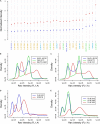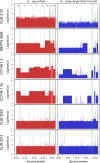Investigation of Genetic Relationships Between Hanseniaspora Species Found in Grape Musts Revealed Interspecific Hybrids With Dynamic Genome Structures
- PMID: 32010076
- PMCID: PMC6974558
- DOI: 10.3389/fmicb.2019.02960
Investigation of Genetic Relationships Between Hanseniaspora Species Found in Grape Musts Revealed Interspecific Hybrids With Dynamic Genome Structures
Abstract
Hanseniaspora, a predominant yeast genus of grape musts, includes sister species recently reported as fast evolving. The aim of this study was to investigate the genetic relationships between the four most closely related species, at the population level. A multi-locus sequence typing strategy based on five markers was applied on 107 strains, confirming the clear delineation of species H. uvarum, H. opuntiae, H. guilliermondii, and H. pseudoguilliermondii. Huge variations were observed in the level of intraspecific nucleotide diversity, and differences in heterozygosity between species indicate different life styles. No clear population structure was detected based on geographical or substrate origins. Instead, H. guilliermondii strains clustered into two distinct groups, which may reflect a recent step toward speciation. Interspecific hybrids were detected between H. opuntiae and H. pseudoguilliermondii. Their characterization using flow cytometry, karyotypes and genome sequencing showed different genome structures in different ploidy contexts: allodiploids, allotriploids, and allotetraploids. Subculturing of an allotriploid strain revealed chromosome loss equivalent to one chromosome set, followed by an auto-diploidization event, whereas another auto-diploidized tetraploid showed a segmental duplication. Altogether, these results suggest that Hanseniaspora genomes are not only fast evolving but also highly dynamic.
Keywords: Hanseniaspora guilliermondii; Hanseniaspora uvarum; MLST; biodiversity; evolution; yeast.
Copyright © 2020 Saubin, Devillers, Proust, Brier, Grondin, Pradal, Legras and Neuvéglise.
Figures






Similar articles
-
Genome sequence of the non-conventional wine yeast Hanseniaspora guilliermondii UTAD222 unveils relevant traits of this species and of the Hanseniaspora genus in the context of wine fermentation.DNA Res. 2019 Feb 1;26(1):67-83. doi: 10.1093/dnares/dsy039. DNA Res. 2019. PMID: 30462193 Free PMC article.
-
Hanseniaspora meyeri sp. nov., Hanseniaspora clermontiae sp. nov., Hanseniaspora lachancei sp. nov. and Hanseniaspora opuntiae sp. nov., novel apiculate yeast species.Int J Syst Evol Microbiol. 2003 Sep;53(Pt 5):1671-1680. doi: 10.1099/ijs.0.02618-0. Int J Syst Evol Microbiol. 2003. PMID: 13130067
-
Hanseniaspora uvarum from Winemaking Environments Show Spatial and Temporal Genetic Clustering.Front Microbiol. 2016 Jan 20;6:1569. doi: 10.3389/fmicb.2015.01569. eCollection 2015. Front Microbiol. 2016. PMID: 26834719 Free PMC article.
-
Genome Sequencing and Comparative Analysis of Three Hanseniaspora uvarum Indigenous Wine Strains Reveal Remarkable Biotechnological Potential.Front Microbiol. 2020 Jan 21;10:3133. doi: 10.3389/fmicb.2019.03133. eCollection 2019. Front Microbiol. 2020. PMID: 32038567 Free PMC article.
-
Heavy sulphur compounds, higher alcohols and esters production profile of Hanseniaspora uvarum and Hanseniaspora guilliermondii grown as pure and mixed cultures in grape must.Int J Food Microbiol. 2008 Jun 10;124(3):231-8. doi: 10.1016/j.ijfoodmicro.2008.03.025. Epub 2008 Mar 31. Int J Food Microbiol. 2008. PMID: 18457893
Cited by
-
Insights into the genomic and phenotypic diversity of Monosporozyma unispora strains isolated from anthropic environments.FEMS Yeast Res. 2025 Jan 30;25:foaf016. doi: 10.1093/femsyr/foaf016. FEMS Yeast Res. 2025. PMID: 40121180 Free PMC article.
-
Evolution and molecular bases of reproductive isolation.Curr Opin Genet Dev. 2022 Oct;76:101952. doi: 10.1016/j.gde.2022.101952. Epub 2022 Jul 16. Curr Opin Genet Dev. 2022. PMID: 35849861 Free PMC article. Review.
-
Gene loss and cis-regulatory novelty shaped core histone gene evolution in the apiculate yeast Hanseniaspora uvarum.Genetics. 2024 Mar 6;226(3):iyae008. doi: 10.1093/genetics/iyae008. Genetics. 2024. PMID: 38271560 Free PMC article.
-
Evaluating the Genome-Based Average Nucleotide Identity Calculation for Identification of Twelve Yeast Species.J Fungi (Basel). 2024 Sep 11;10(9):646. doi: 10.3390/jof10090646. J Fungi (Basel). 2024. PMID: 39330406 Free PMC article.
-
Copper-based grape pest management has impacted wine aroma.Sci Rep. 2024 May 2;14(1):10124. doi: 10.1038/s41598-024-60335-9. Sci Rep. 2024. PMID: 38698114 Free PMC article.
References
-
- Bizzarri M., Cassanelli S., Bartolini L., Pryszcz L. P., Duskova M., Sychrova H., et al. (2019). Interplay of chimeric mating-type loci impairs fertility rescue and accounts for intra-strain variability in zygosaccharomyces rouxii interspecies Hybrid ATCC42981. Front. Genet. 10:137. 10.3389/fgene.2019.00137 - DOI - PMC - PubMed
LinkOut - more resources
Full Text Sources

